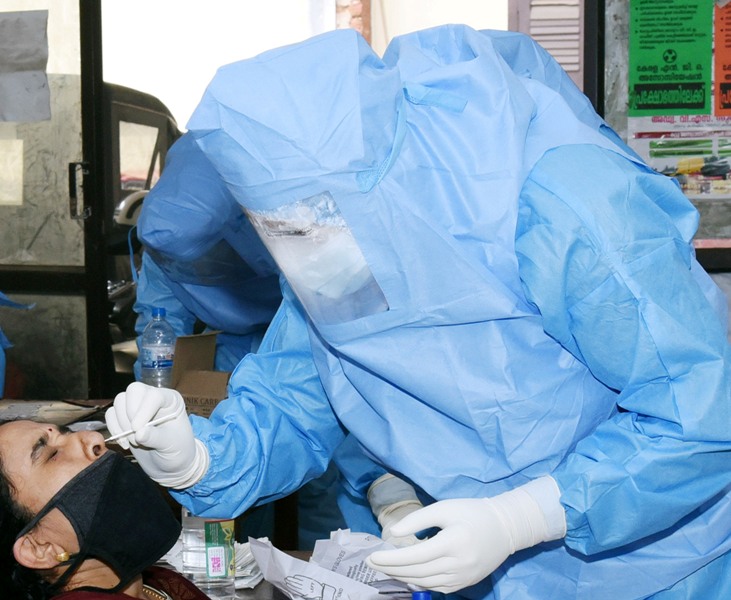 COVID19
COVID19
Lack of prevention can surge Covid cases, warn Experts
Kanpur/UNI: Active cases, which had mounted to around 10 lakhs in September, could again witness a rise if proper Corona protocols are not followed, an expert committee "COVID-19 India National Supermodel" has warned.
The experts feel that the downward trend will continue only if measures like maintaining social distancing, wearing masks and washing hands frequently are adhered to.
In addition, based on temporal profiles of analysis done for Bihar and Uttar Pradesh, the Committee concluded that the impact of labour migration on the total number of infections in these states was minimal. This observation indicates the success of quarantine strategies adopted for the returning migrants.
The Committee, which disclosed its finding here on Sunday during a virtual press conference, also simulated what would have happened in hypothetical alternative scenarios with regard to the timing of lockdown regime.
The expert committee was constituted by the Department of Science and Technology (DST) to collate the collective expertise of the Indian scientific community, and to arrive at a “COVID-19 India National Supermodel."
The committee included Prof M Vidyasagar (IIT Hyderabad), Prof Manindra Agrawal (IIT Kanpur), Lt Gen Madhuri Kanitkar (HQ IDS MoD), Prof Biman Bagchi (IISc), Prof Arup Bose (ISI Kolkata), Prof Gagandeep Kang (CMC Vellore) and Prof Sankar K Pal (ISI Kolkata).
The findings of the committee on lockdown ,based on the mathematical model developed by the Committee, says that if there was no lockdown, the pandemic would have hit India very hard, with a peak load of 140+ lakh cases arriving in only June. Given our lack of preparedness back then, the healthcare system would have been overwhelmed, leading to many additional deaths.
Secondly, they said, had India waited until May to impose the lockdown, the peak load of active cases would have been around 50 lakhs by June.
''In actuality, the peak of active cases came in late September at around 10 lakhs. By this time, we were far better equipped to handle the pandemic in terms of diagnostics and vital equipment inventories''.
Therefore, the imposition of an early and comprehensive lockdown pushed the peak of cases far into the future and also reduced the peak load on the system. In short, the lockdown “flattened the curve” , the committee stated.
An analysis of the actual deaths from the pandemic with various alternative scenarios also says that without a lockdown the number of deaths in India would have overwhelmed the system within a very short timeframe, and would eventually have crossed 26 lakhs fatalities.
"Imposing the lockdown in May would have reduced deaths to around 10 lakhs.
The prompt imposition of the lockdown on March 24 has resulted in deaths being around 1 lakh till date," the expert team said.
The team, in its recommendations, said the imposition of various safety protocols such as wearing masks, social distancing etc., together with a comprehensive lockdown has allowed India to fare better than many other countries.
India has one-sixth of the world’s population (one-fifth excluding China), and one-sixth of the reported cases. However, India accounts for only 10 per cent of the world’s deaths, and its case fatality rate of less than 2 per cent is among the lowest in the world . India’s fatality rate per million is about a tenth that of the European countries and the USA.
In view of coming winter and the scenarios analysed, as well as the upcoming festival season the committee has strongly recommended that the existing personal safety protocols need to continue in full measure. Otherwise we will see a sharp rise in infections. Avoiding congestion especially in closed spaces and special care of those above 65 years and children is even more significant. Personnel with co-morbidities need to be extra cautious.
Fresh lockdowns should not be imposed on a district and state wide levels, unless there is imminent danger of the healthcare facilities being overwhelmed.
The Committee said that it will continue to work on many other issues concerning the current pandemic forecasting, as well as continue to develop robust models for the future pandemics if any so that the decision-making processes are fast tracked when the need arises without a lag time.
Support Our Journalism
We cannot do without you.. your contribution supports unbiased journalism
IBNS is not driven by any ism- not wokeism, not racism, not skewed secularism, not hyper right-wing or left liberal ideals, nor by any hardline religious beliefs or hyper nationalism. We want to serve you good old objective news, as they are. We do not judge or preach. We let people decide for themselves. We only try to present factual and well-sourced news.







